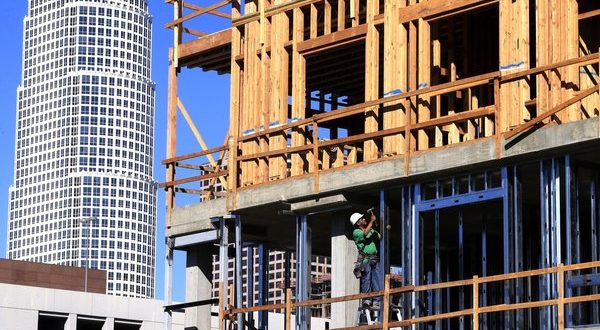California's population rises to 38.3 million during 2013
Published on May 5th, 2014
Scott Gold, Anh Do, Lee Romney
April 30, 2014
LA Times
Fueled by robust growth in the San Francisco Bay Area, California’s population continued its slow, steady ascent last year, adding 1,000 residents each day in 2013 to bring the number of people in the nation’s largest state to 38.3 million.
The report released Wednesday by the state Department of Finance underscored broad patterns that its authors said would continue in coming years: residents trickling out of rural areas and consolidating around urban centers, and increasing numbers of people in apartments and other multi-family housing developments.
Every county in Southern California grew. Los Angeles County topped the 10-million mark following 0.8% growth, and the city of Los Angeles neared 4 million people after growing by more than 38,000 people, or a full percentage point.
Remote pockets of the state lost population in 2013. Amador County, for example, where velveteen hills were plundered during the Gold Rush, lost 1.2% percent of its 36,581 residents. California cities more than compensated for the loss. Of 482 California cities included in the report, 439 saw population gains.
The report also illustrated California’s efforts to keep pace with housing stock, said Doug Kuczynski, a state research program specialist. The state added 59,426 housing units in 2013, compared with a net increase in 2012 of 45,367 units — a 31% higher growth rate.
Increasingly, fewer of those units are single-family homes, and more of them are in multi-family complexes such as apartment buildings, Kuczynski said.
Los Angeles added more units — more than 7,000 — than any other city. But all of that net growth was in multi-family units; in 2013, Los Angeles demolished more single-family homes than it built, Kuczynski said. San Francisco added 2,377 housing units, just 24 of which were single-family homes.
“That’s the bulk of the growth,” Kuczynski said. “We expect that to continue.”
Irvine added 11,000 residents in 2013 — the fourth highest increase in the state, despite the fact that it is not one of California’s larger cities. Irvine added the second-most housing units in the state — 4,186 units, more than were added in San Jose, San Diego or San Francisco.
Many of the houses sprouting up around Irvine’s Great Park are marketed to Asians and Asian Americans. FivePoint Communities, a developer, pays close attention to feng shui, an ancient Chinese art designed to balance the flow of energy in a space.
The company plans to build up to 9,500 homes, working with experts to ensure that everything from layout to street names foster a feeling of harmony. “When we choose where to live, we need to focus on something inspirational, desirable,” said Lon Wen, who recently shopped for homes in the new development.
Despite the building boom, demand remains high.
“The competition to buy is insane,” said Kim Madolora, an Irvine resident and mother of two. “Where else can you live with a park at every corner and so many things for kids to do?”
She lauded the city’s low crime rate, its school system and its community spirit — a recent jogathon at her daughter’s elementary school surpassed its $30,000 goal by $16,000. The houses next door and across the street from her home both sold in a day, to cash buyers.
“I have a lot of friends wanting to come here,” she said. “But they can’t get in.”
Mindy Baker, who has five children, arrived in Irvine just over three years ago, needing a good preschool, elementary school, middle school and high school.
“That’s why people choose to come here,” said the transplant from Ontario, Canada.
Her children are now ages 8 to 18. “We have 10 years until our youngest graduates from high school,” she said. “We want to stay.”
The state’s most significant growth took place in the San Francisco Bay Area, where a booming technology sector has helped push unemployment rates to record lows — 5.2% in San Francisco County in March, far below the state rate of 8.4%.
Tourism has rebounded and job growth has spurred a boost in construction, retail and healthcare jobs, said Stephen Levy, director and senior economist of Palo Alto’s Center for Continuing Study of the California Economy.
Three of the five fastest-growing counties were in the Bay Area. Santa Clara County was the fastest-growing, at 1.5%, followed closely by Alameda. Santa Clara County includes San Jose, the state’s third-largest city, which topped 1 million residents for the first time.
The growth has spurred debate. Protests over displacement of longtime San Francisco tenants are a weekly happening and some alarmed by the region’s transformation have called for a moratorium on market-rate housing until ample affordable units are created.
“There are, at least among residents, conflicting views,” Levy said. “They love the jobs and the income and no one likes the pressures that are created in terms of traffic and housing prices and rents. But they are tied together.”
San Francisco’s SPUR, a nonprofit urban planning and good-government organization, has called for reform of slow-growth policies that have eroded the region’s pipeline of new housing.
“We’ve really become one of the most dynamic economies in the country,” said Executive Director Gabriel Metcalf. “But we are now coping with growing pains.”
Gold reported from Los Angeles, Do from Irvine and Romney from San Francisco.





